Isn’t Speed Density inferior and MAF the best tuning solution on a Fox Body Mustang?
Nearly 30 years after Ford stopped production, the Fox Body Mustang remains insanely popular at the race track. There’s probably no single chassis you see more of at the average drag race track, and there is good reason for that!
Until 1986, Mustang fans relied on good old four-barrel carburetors for providing the fueling. But then Ford released the first EFI system for its venerable 5.0-liter engine, which completely changed the industry. Initially feared by enthusiasts as change always takes some getting used to. They knew how to adjust their carburetor, this was all new, and involved computers, scary! And as anything that’s new and scary can do, particularly when it’s not all that well understood just yet, it generated some rumors over the years as to what works, and what doesn’t. We’ll try to get to the bottom of that here in this article.
The rumors:
We’ve all heard them. But I decided to Google/DuckDuckGo them up to see what rumors remain out there in the wild still today.
-
- “SD (speed density) is a little faster/more powerful. but once mods get heavy (esp cams with diminished vacuum), MAF is more adaptable on its own.”
- “With Mass Air the ECU is supposed to accept anything under the sun in the modification world without problems. With Speed Density you can do everything but a Cam change. If you do so you will have idle surges and cause the car to sometimes shut down.”
- And there are other iterations, but generally—these two cover the claims pretty well. In general, the consensus of the ‘street knowledge’ of the Fox Body Mustang community for years, decades even, was “Speed Density has limitations, and MAF just automatically adjusts no matter what modifications you make to your Mustang so it’s better.”
But is any of that true? Well… let’s just say perspective and control capability is key. And that there is a lot more to it than what those rumors claim. Wanna know how to make the MOST of your engine regardless of whether you’re running Speed Density or Mass Air Flow? Read on and we’ll show you the ways….

First – A little history:
Starting back in 1986, Ford used the Speed Density EEC-IV Engine Management System in the Fox Body Mustang. This was installed on all V8 models from 1986 to 1988 and then switched to Mass Air Flow design from 1989 onwards known as the A9L EEC-IV ECU. The only exception was 1988 models bound for California, which had MAF fuel injection a year before due to tighter emissions regulations. Back in the late 80s, this new Fuel Injection tech was cutting-edge technology, and Ford Mustang fans were initially reluctant, thinking that the era of tinkering with your car was over and that they would not be able to improve their car’s performance. However, this was not the end; far from it, it was the beginning of the new age of muscle car performance where adjusting the carburetor was replaced by tuning the mustang and/or programming the ECU.
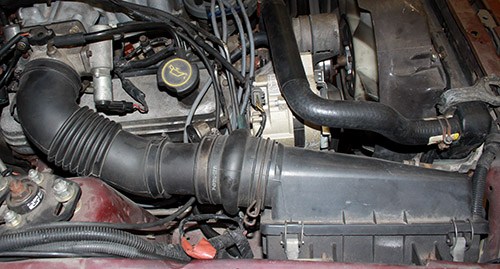
Speed Density Systems in the Fox Body Mustang – An Overview
Speed Density Engine Management Systems are fairly common electronic fuel injection systems that rely on two main factors – air pressure and engine speed. There is a MAP sensor (Manifold Air Pressure) which measures the pressure of air entering the engine inside the intake manifold, while the tach (rpm) signal provides the engine’s rpm value. Using those two components, the ECU ‘looks up’ the amount of fuel needed in the ECUs volumetric efficiency table. That Volumetric Efficiency table essentially maps out how well the engine fills the combustion chambers at various different loads (think throttle) and engine speeds (RPMs). It answers the question ‘does this cylinder, at 20% throttle/load and 3000 rpms, fill completely?’ The answer is almost always NO, so the VE table is populated with a number that represents the percentage of how well that cylinder fills with air at atmospheric pressure at each and every load and rpm point. This builds a table of values, sometimes called a ‘fuel map’ for short.
You can also use speed density for ignition timing. This uses a table similar in appearance to the VE table, where the ECU uses a chart of what timing to run based on RPM and MAP sensor readings. The concept is similar to an old vacuum advance distributor: as the MAP reading drops (vacuum increases), this table will be used to bring in more ignition timing advance. But where-as a vacuum advance distributor’s advance curve is fixed based on weights in the distributor, and all-in is a fixed amount of ignition advance, with electronic control there is infinitely more flexibility. You can change how much timing advance gets brought in under vacuum at different RPMs. And if you have a boosted engine, you compensate for that in the ignition table as well, and the ECU can reduce the timing advance as the MAP sensor readings increase under boost. You can dial that curve into perfection and account for special circumstances too. Wanna bring all the power in as fast as possible as you spool your turbo, but then right at the torque peak back off the ignition advance a little bit to go easy on your rods, then bring the timing advance back in for max horsepower at higher rpms? You can do that…..
Speed Density also uses an intake air temperature (IAT) sensor in the intake manifold and a narrowband oxygen sensor mounted in the exhaust. The intake air temp sensor is used to help calculate air density, and is applied as a correction factor that determines how much air is moving through the engine in order for the ECU to properly fuel the engine to reach the targeted Air Fuel Ratio. The oxygen sensor then does what its namesake suggests and measures any oxygen remaining in the exhaust after combustion to determine if the ECU is properly fueling the engine to meet the ECUs targeted Air/Fuel Ratio—and the ECU can use that information to apply corrections. Running a little lean? Add a little fuel to compensate, measure the impact at the O2 Sensor, and repeat the process adding/removing fuel to ‘correct’ the fueling.
Something to consider about using Ford’s Speed Density System is that the type of fuel injection system is not equipped with sensors to directly measure airflow, so any significant change to the engine in terms of performance cylinder heads or camshafts will need some touch-up to the tune or programming of the ECU. That is precisely why it wasn’t received well when it was introduced in 1986, because Fox Body Mustang owners realized that bolting a set of high-flow cylinder heads and a big lopey camshaft didn’t always make the car more powerful. In fact, it was possible it could have made it even slower since the engine’s ECU was still tuned for the factory engine’s needs (VE or Volumetric Efficiency), which could make the vehicle deliver less power than stock, or in some cases could even put the engine at risk of being hurt due to an overly lean mixture at high loads which could lead to detonation/knock.
So Speed Density is crap, right?
Not even close. And neither is MAF. We’ll circle back to that in a moment though….
Ultimately—here’s what you need to know. Speed Density CALCULATES the amount of airflow entering the engine. It does not directly measure airflow. Speed Density uses a number of sensors/inputs (IAT, MAP, and engine speed) along with the pre-programmed/tuned data in the VE table which ‘do the math’ and determine how much air is entering the engine. Then, once it knows how much air is entering the engine based on this math—it knows how much fuel to inject to achieve the air/fuel ratio that is being targeted, regardless of what load or rpm you are operating at.
It’s calculated. Based on data from sensors and the VE table. Good data will lead to good results. Bad data will lead to poor results. It’s as simple as ‘garbage in, garbage out’. Speed Density is not inherently ‘good’ or ‘bad’. It is a powerful method for calculating an engine’s needs, and providing them. Configured and tuned properly, the results are excellent.
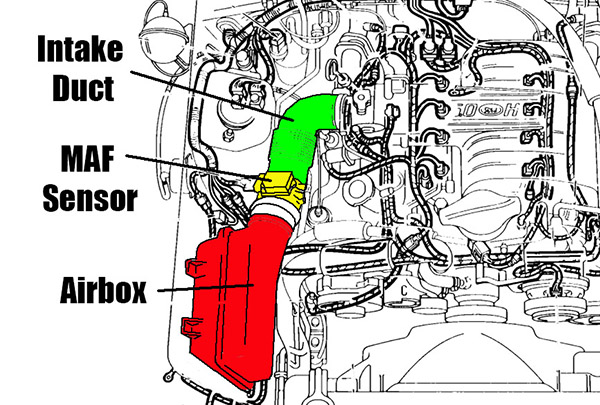
Mass Air Flow Systems — Overview
The MAF (Mass Air Flow) has since become the more common fuel injection system used on most modern cars and all Ford Mustang V8s since 1989. The driver of this evolution was not performance oriented however, but was primarily emissions minded. We’ll get to why that is in a moment.
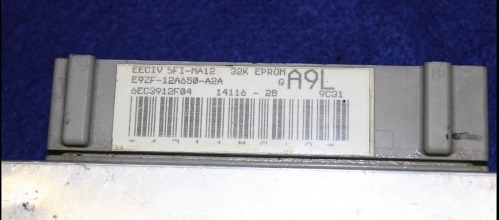
The main component of this system is the MAF sensor (Mass Air Flow Sensor) which is located on the intake plumbing upstream of the throttle body—outside of the intake manifold. The job of the MAF sensor is to precisely measure the amount of air going into the engine. It is designed to be used on a known size intake tube, and the sensor itself measures two things—air temperature, and how fast that incoming air can cool off a ‘hot wire’ that the MAF sensor heats up. The concept is simple—apply X amount of electrical current to heat a metal wire up, place that wire in the flow of incoming air, and measure how difficult it is, how much current is required, to keep that hot wire hot. That’s pretty much it. So in a sense, the sensor itself is still CALCULATING airflow. It’s doing this independently of the ECU, so the ECU/Engine Management System (in this case the EEC-IV ECU) receives a signal from the Mass Air Flow sensor telling the ECU exactly how much airflow the MAF believes is passing into the engine. So long as the MAF is properly calibrated and fit to the factory intake tubing such that the diameter and airflow directional characteristics are not changed—you could say that a Mass Air Flow system MEASURES the airflow… even though… you know… it’s still a calculation really.
This means that MAF-equipped engines are not relying on a predefined set of values (a la VE Table) for calculating the amount of fuel entering the engine, but using direct information provided by the sensors and calculating the fueling needs in real time. MAF based systems instead have a ‘Target Air Fuel Ratio’ table that is used to determine how much fuel to spray from the fuel injectors for a given amount of air. (Speed Density systems can also have a Target Air/Fuel Ratio table generally used for EGO Corrections using an oxygen sensor FYI)
For instance… at high load/wide open throttle and mid-high RPMS, where you’re making all the torque and horsepower of which you crave—assuming you’re running gasoline, you might want to be at a 13:1 Air Fuel Ratio on a naturally aspirated Ford Mustang 5.0 engine. That means for every 13 lbs of air that enters the engine the ECU needs to spray one pound of fuel, gasoline in this case. Since the Mass Air Flow Sensor is directly measuring air entering the engine it knows how many pounds of air are flowing, and can then command the proper amount of fueling to pretty much nail that target Air/Fuel Ratio of 13:1 on the first try. Pretty cool, right?
Ignition timing advance control with MAF based ECUs also uses a spark table, but instead of a MAP sensor, the simplest MAF based timing controls use a chart of ignition timing based on engine RPM and the MAF sensor reading. Overall this works reasonably well. It can however make spotting where the engine is at full throttle or, on turbo or supercharged vehicles, can make determining when you’re operating under boost a little tricky. Ford’s EEC-IV ECUs got around the question of whether the spark table was at full throttle by having the ECU look at the throttle position sensor and use a full throttle only chart of timing advance as a function of RPM, ignoring the MAF. Another trick that some ECUs use (including the MegaSquirt line) is to do a few calculations to estimate a MAP sensor reading from the MAF, making for a spark table that looks a lot like a speed density spark table.
Why though? Why would Ford make the change to Mass Air Flow? And what makes it better than Speed Density for performance applications? Well…. Does MAF make it better? Really?
First—the why. In a word— Emissions. Particularly aiming to keep emissions minimal for a vehicle over its (hopefully) long lifespan. Speed Density does not have an inherent method to adapt over time to the Volumetric Efficiency of the engine changing throughout its lifetime due to wear and lack of maintenance. (well, it can through another process known as real-time trims, but that’s another topic). Back to MAFs.
Don’t change your oil frequently enough? You might wear the piston rings/cylinder walls and have a bit of blowby getting past the rings. That air is no longer flowing through the engine at the same rate it once was and is no longer making power—there is less of it in the cylinders to mix with fuel now. The effective VE of your engine is reduced. The ECU is likely sending too much fuel. You’re running a bit rich.
Don’t clean or replace your air filter? You’ve got an intake restriction. The VE of your engine is reduced. The ECU is likely sending too much fuel. You’re running a bit rich.
That covers a couple of maintenance related examples. What about performance related examples, you’re looking to make all the horse-ponies and torque-powers right?
You install a new free-er flowing intake manifold. You’ve increased the VE of your engine at higher RPMs (and possibly decreased it a bit at low RPM but that’s another story). The ECU doesn’t know this—and is likely not sending ENOUGH fuel to compensate at high RPMs where this intake makes its positive impact. You’re running lean.
Heads? Camshaft? Same story. More airflow requires more fuel flow, but your VE table hasn’t changed. That’s NOT a weakness of Speed Density—but it IS a weakness of any system if it cannot be tuned properly for these changes. Stock Ford Mustang Speed Density systems struggle here, hence the reputation you may have heard of and that this article aims to provide some clarity on. Tunable Speed Density systems though can be a POWERFUL solution for these, and any, vehicle.
In other words—if you’re sending garbage in and getting garbage out…. You shouldn’t be surprised! But if you could send GOOD data in again, by correcting the VE table to match the VE of your new combo with the current engine modifications—you’d be solid.
In short– The VE table is pre-tuned on the stock ECU, and aside from using O2 Sensor feedback to apply corrections, if the VE of your engine changes—the VE table needs to change to match. If the VE table doesn’t change to match the different VE of your engine—there is a mismatch. But what if you could make it match no matter what modifications you made to your engine? You can. We’ll get there…..
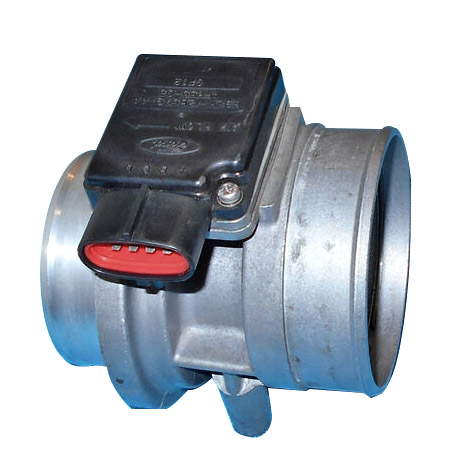
Back to the MAF….
So what it really comes down to, what people found beneficial in the Ford Mustang world that helped create the rumor…. Is the flexibility of a MAF to compensate for MINOR changes in an engines volumetric efficiency. This is incredibly convenient for Ford as an OEM manufacturer that must adhere to emissions standards on road-going cars, as they can be confident that regardless of whether or not you fail to maintain your engine their system can compensate and make minor tweaks as needed to keep your emissions in check.
For the Fox Body Mustang community, introducing the Mass Air Flow system in 1988/1989 was significant since the ECU could adjust its fueling depending on the changed airflow by direct measurement of that airflow. This means that typical engine bolt-ons like an upgraded intake, high-flow cylinder heads, a mildly more aggressive camshaft, and performance exhaust could be installed -and at least to some degree, the MAF system could automatically compensate for the changes in the engines overall Volumetric Efficiency without need for a change to the ECU tune. (Are you REALLY getting all the power out of it though still? I’ll give you a hint…. No. The power is in the ignition timing in large part—we’ll discuss that here in a moment, and we can help there too!)
However, as much as the factory MAF system is ideal for near stock applications and mildly modified engines, the Mass Air Flow systems using the stock ECU have their limits as well. When you start chasing real horsepower, you’ll want as much air as possible, and, likely, you will eventually hit the limit of your MAF sensor. In that case, you will need to upgrade to a bigger MAF sensor ($$$) that is capable of calculating more airflow and will definitely require an ECU tune or some half-fast (say that quickly) black box piggyback attempt to fake the stock ECU into proper fueling in order to make everything work properly.
Wait—what did I just say?
In short—just like you can outgrow your stock Speed Density system if you start modifying your engine, you can outgrow your stock MAF system just the same. In both cases, it’s garbage in- garbage out.
And what if you’re making changes big enough to require enough fuel flow to outgrow the stock fuel injectors at their measly 19lbs of flow rate? That’s only about 285hp. Who wants a Fox Body Mustang with only 285hp? That’s weaksauce! And if you’re on our site, you know that’s weaksauce, and my guess… you don’t want any of that. You want to know what it takes to do this, and do it right, at ANY horsepower level, and on any engine. I hope this helps you on your mission! (Though this article is Ford Mustang focused what we’re talking about is nearly universally applicable to all internal combustion engines)
So what makes people think SD is inferior to MAF?
People put garbage in, they got garbage out, and they said “HEY! THIS SMELLS LIKE GARBAGE!”.
Along with the advent of MAF EFI (using the A9L ECU) systems being used on the Fox Body Mustang came a new generation of tools to help you manipulate your ‘tune’ using little trickster black boxes that modify the signal from the MAF, sortof a piggyback approach that ‘tricks’ the stock ECU into performing differently. Why would you do that? These solutions tend to be more costly in the long term than just doing it right up front giving yourself full control that a standalone engine management system can offer. They tend to be finicky as you still have to ‘tune’ the half-fast black box, often with a screwdriver giving you incredibly limited control. And when you’re done, and you upgrade your engine again and outgrow the airflow needs, you get to buy a bigger MAF and try and trick the stock ECU again.
There is a better way.

So, I guess Speed Density is always better for performance purposes then, right?
Not so fast. The reality is, either can and will do the trick—but you need to be able to tune them properly. That’s the key, you MUST have the controllability and tunability to ensure that no matter what method the ECU uses to calculate your engine’s fueling needs, that it’s right. The tools that would allow you to do that were not available (or were very complicated) in the early days for the Speed Density Fox Body Mustang, and due to the fact that these systems were only used for a couple of years and were then replaced on new Ford Mustangs by the factory with the newer MAF based systems, and there were more year-models of MAF cars than SD cars, MAF cars got most of the attention from the aftermarket. It’s pretty simple, just follow the money right?
OK so I’m following the money—obviously this website is just trying to convince me that Speed Density is best because that’s what your systems you’re selling use, right?
Umm….. nope! Our systems support EITHER Speed Density OR Mass Air Flow/MAF approaches to tuning your engine. Our preference in practice when we’re tuning MOST vehicles, yes, is Speed Density. We can do either (as well as Alpha-N, and some fancy proprietary blended modes like ITB Mode)
Why do we prefer Speed Density in most cases? Well…
- It’s just so darn flexible. You can tune nearly any engine easily. You can modify that engine, and EASILY dial the VE table in to match your engine’s new Volumetric Efficiency with the changes you’ve made. And then when you modify it again, your system is there for you again.
- Speed Density is ready for BOOST out of the gate. That MAP sensor can not only read vacuum like will be seen in almost all cases on a naturally aspirated car—but it can read when that supercharged Mustang starts making positive pressure in the intake manifold, or when that turbo Mustang starts making steam, and you can tune the Volumetric Efficiency of your engine under boost just the same as you can in vacuum. At all levels of load (throttle and airflow) and engine RPMs.
- The kicker!! There’s another benefit in speed density that you just can’t get with a MAF. In general, Mass Air Flow sensors put something in the pathway of the airflow in order to be able to measure airflow—a hot wire generally, but often with some plastic or metal structure holding it in place and such. This is a dyno-verifiable intake restriction I’ve personally seen make a noticeable and repeatable difference in power simply by removing that airflow restriction and replacing it with a smooth tube for unrestricted airflow.
- Seriously– check out the images below. This is NOT the way to maximum horsepower.
- Cost when going big—it’s a lot cheaper to upgrade a cheap MAP sensor to go to higher levels of boost than it is to buy a bigger MAF sensor. And you have to be able to tune for the changes in either case so you can figure that cost (ECU or blackbox) as flat. And our MSPNP ECUs all come with a 4 bar (44psi turbo boost capable) MAP sensor. You’re going to outgrow your stock block, and some aftermarket blocks, at those boost levels way before you run out of MAP sensor. We give you plenty of room to grow!
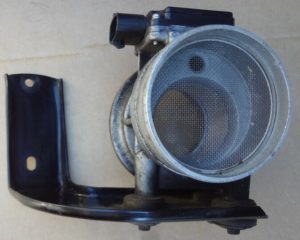 |
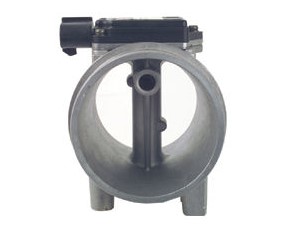 |
So while MAF will do the trick, and some Mass Air Flow Sensors are less restrictive than others, a smooth tube will outflow even the best of them. One less component in the system leads to less complexity overall. For these reasons and several others outlined above– we really like working with speed density systems so long as they give you FULL CONTROL of the tune. We can help you with that as well. Read on.
So… what is needed to properly tune my Fox Body Ford Mustang?
Well…. I’m glad you asked!
We’ve talked mostly about fueling above—let’s quickly discuss ignition timing tuning. You tune the fuel to make the engine run safely and efficiently. But that’s not where most of the power is. You’ll find most of the power in ignition timing tuning. And that’s another area where a fully tunable system is critical. We can help you there too. Oh, and you’re racing this thing right? So I bet launch control/2-step capability sounds cool. Oh, you’ve got a Turbo Mustang? Well, you probably would love the ability to tune your turbo boost curve to come on strong and hold on all the way to redline making exactly the amount of boost you know you can safely make, right? Oh you’ve got a Supercharged Mustang? We can help you there too with safeties to protect your engine in the event something goes wrong. And with a lot of other killer features that will make your car faster, and help you to make all the power you can make– safely.
My recommendation for most customers with a Fox Body Mustang? We’ve got two options. MSPNP Gen2, and MS3Pro PNP ECUs. Both will get it done and control your engine with excellence, putting the power in YOUR hands. The MS3Pro PNP takes it to another level with features and performance, adding sequential fueling and optionally, sequential ignition, along with onboard datalogging and a stack of additional and improved features!
-
- MSPNP Gen2 part# MSPNP2-EEC4A8. The MSPNP line is plug-and-play, and these PNP ECUs for Ford Mustangs make standalone engine management EASY to install in your car.
Ford Mustang FoxBody 5.0 1986-1993 MSPNP Gen2 Plug and Play ECU
- Full control of your fuel and ignition tables
- Launch control aka 2-step
- Flat shift/no lift shifting
- Flex Fuel/E85 Support with added flex fuel sensor.
- Electronic Boost Control (requires boost solenoid, but they’re cheap)
- Allows use of a wideband oxygen controller/sensor to real time fueling corrections.
- Table switching- Change the fuel and spark maps on the fly with a switch
- Safeties like Overboost Protection can save the day if you turn the boost up too high.
- Real time barometric correction
Furthermore, it’s getting harder and harder to find a replacement A9L Mustang ECU, and without layering some other solution (chip, software, etc) on top of it, you still don’t have a tunable solution. The MSPNP is the perfect A9L Replacement ECU that takes your capabilities to the NEXT LEVEL. You can tune this ECU to perfectly match the needs of your engine with capabilities giving you MUCH more power and control than an A9L ever could.
Wanna take it to the next level? Bring on the MS3Pro PNP (aka MSPNP Pro)!!!
It’s the MSPNP on steroids. Everything I just listed above for the MSPNP2, but the list just keeps going.
- Higher resolution tables for fuel and ignition.
- Sequential Fuel Injection.
- Optional Sequential Ignition (aka Coil On Plug or Coil Per Plug) capabilities for insane ignition system energy potential.
- Onboard datalogging to an SD Card inside the ECU, allowing for easy download of log files onto your laptop across the USB/Tune Cable.
- Every major feature from launch, idle, knock control through nitrous, turbo boost control, etc are refined and improved.
- Additional Engine Safeties and Shutdowns– get a warning light, or just shut down the party, if something starts to go awry. Too much boost? Temps too high? AFR too lean? Give yourself a warning– or shut it down automatically and save the day!
This PNP ECU for the FoxBody Mustang is for serious.
Ford Foxbody Mustang 5.0 1986-1993 MS3Pro PNP Plug and Play ECU

Is it hard to install an MSPNP Gen2 or MSPNP Pro (MS3Pro) PNP ECU for the Fox Body Mustang?
Not at all. In most cases the average person that does some of their own work on their car can install one of these systems in less than an hour. It’s simple. You remove the stock EEC-IV ECU, unplugging it from the factory wiring harness, and you plug the MSPNP into the factory harness and mount it in its place. You route a single vacuum line (included) to your intake manifold through an existing hole in the firewall. We walk you through it all. You fire the engine up, set base timing, and the base map on the unit is dialed in fairly well for a near stock vehicle as a starting point. Need to run bigger fuel injectors? No problem—that’s just a couple settings away and we walk you through it. And you’re ready to dial your car in for maximum performance in no time at all. You can tune on a dyno, or on track.


